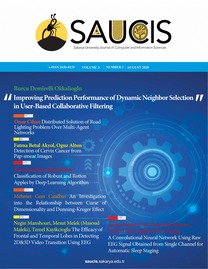Classification of Robust and Rotten Apples by Deep Learning Algorithm
Sağlam ve Çürük Elmaların Derin Öğrenme Algoritması ile Sınıflandırılması
___
[1] H. Kurt, Ş. Ö. Keşkek, T. Çil, and A. Canataroğlu, “Meme kanserli hastalarda tamamlayıcı/alternatif tedavi kullanımı,” Türk Onkol. Derg., vol. 28, no. 1, pp. 10–15, 2013.[2] C. A. Perussello, Z. Zhang, A. Marzocchella, and B. K. Tiwari, “Valorization of apple pomace by extraction of valuable compounds,” Compr. Rev. Food Sci. Food Saf., vol. 16, no. 5, pp. 776– 796, 2017.
[3] O. Cömert, M. Hekim, and K. Adem, “Faster R-CNN Kullanarak Elmalarda Çürük Tespiti,” Uluslararası Mühendislik Araştırma ve Geliştirme Derg., vol. 11, no. 1, pp. 335–341.
[4] V. Leemans, H. Magein, and M.-F. Destain, “On-line fruit grading according to their external quality using machine vision,” Biosyst. Eng., vol. 83, no. 4, pp. 397–404, 2002.
[5] M. M. Sofu, O. Er, M. C. Kayacan, and B. Cetişli, “Elmaların görüntü işleme yöntemi ile sınıflandırılması ve leke tespiti,” Gıda Teknol. Elektron. Derg., vol. 8, no. 1, pp. 12–25, 2013.
[6] Y. Lu and R. Lu, “Detection of surface and subsurface defects of apples using structuredillumination reflectance imaging with machine learning algorithms,” Trans. ASABE, vol. 61, no. 6, pp. 1831–1842, 2018.
[7] R. Siddiqi, “Automated apple defect detection using state-of-the-art object detection techniques,” SN Appl. Sci., vol. 1, no. 11, p. 1345, 2019.
[8] Y. Yu, S. A. Velastin, and F. Yin, “Automatic grading of apples based on multi-features and weighted K-means clustering algorithm,” Inf. Process. Agric., 2019.
[9] O. Kleynen, V. Leemans, and M.-F. Destain, “Development of a multi-spectral vision system for the detection of defects on apples,” Journal of Food Engineering, vol. 69, no. 1, pp. 41–49, 2005.
[10] B. Zhang et al., “Principles, developments and applications of computer vision for external quality inspection of fruits and vegetables: A review,” Food Res. Int., vol. 62, pp. 326–343, 2014.
[11] S. Cubero, W. S. Lee, N. Aleixos, F. Albert, and J. Blasco, “Automated systems based on machine vision for inspecting citrus fruits from the field to postharvest—a review,” Food Bioprocess Technol., vol. 9, no. 10, pp. 1623–1639, 2016.
[12] A. Folch-Fortuny, J. M. Prats-Montalbán, S. Cubero, J. Blasco, and A. Ferrer, “VIS/NIR hyperspectral imaging and N-way PLS-DA models for detection of decay lesions in citrus fruits,” Chemom. Intell. Lab. Syst., vol. 156, pp. 241–248, 2016.
[13] X. Zhu and G. Li, “Rapid detection and visualization of slight bruise on apples using hyperspectral imaging,” Int. J. Food Prop., vol. 22, no. 1, pp. 1709–1719, 2019.
[14] Z. Du, X. Zeng, X. Li, X. Ding, J. Cao, and W. Jiang, “Recent advances in imaging techniques for bruise detection in fruits and vegetables,” Trends Food Sci. Technol., 2020.
[15] X. Zeng, Y. Miao, S. Ubaid, X. Gao, and S. Zhuang, “Detection and classification of bruises of pears based on thermal images,” Postharvest Biol. Technol., vol. 161, p. 111090, 2020.
[16] M. Zhang, Y. Jiang, C. Li, and F. Yang, “Fully convolutional networks for blueberry bruising and calyx segmentation using hyperspectral transmittance imaging,” Biosyst. Eng., vol. 192, pp. 159–175, 2020.
[17] Y. LeCun et al., “Backpropagation applied to handwritten zip code recognition,” Neural Comput., vol. 1, no. 4, pp. 541–551, 1989.
[18] R. P. Lippmann, “Review of neural networks for speech recognition,” Neural Comput., vol. 1, no. 1, pp. 1–38, 1989.
[19] B. Yuan, “Efficient hardware architecture of softmax layer in deep neural network,” in 2016 29th IEEE International System-on-Chip Conference (SOCC), 2016, pp. 323–326.
[20] A. Kamilaris and F. X. Prenafeta-Boldú, “Deep learning in agriculture: A survey,” Comput. Electron. Agric., vol. 147, pp. 70–90, 2018.
[21] J. Wan et al., “Deep learning for content-based image retrieval: A comprehensive study,” in Proceedings of the 22nd ACM international conference on Multimedia, 2014, pp. 157–166.
[22] M. I. Razzak, S. Naz, and A. Zaib, “Deep learning for medical image processing: Overview, challenges and the future,” in Classification in BioApps, Springer, 2018, pp. 323–350.
[23] C. Tian, Y. Xu, L. Fei, and K. Yan, “Deep Learning for Image Denoising: A Survey,” Int. Conf. Genet. Evol. Comput., pp. 563–572, 2018.
[24] V. Leemans and M.-F. Destain, “A real-time grading method of apples based on features extracted from defects,” J. Food Eng., vol. 61, no. 1, pp. 83–89, 2004.
[25] J. Xing and J. De Baerdemaeker, “Bruise detection on ‘Jonagold’apples using hyperspectral imaging,” Postharvest Biol. Technol., vol. 37, no. 2, pp. 152–162, 2005.
[26] D. Unay and B. Gosselin, “Automatic defect segmentation of ‘Jonagold’apples on multi-spectral images: A comparative study,” Postharvest Biol. Technol., vol. 42, no. 3, pp. 271–279, 2006.
[27] D. Unay, B. Gosselin, O. Kleynen, V. Leemans, M.-F. Destain, and O. Debeir, “Automatic grading of Bi-colored apples by multispectral machine vision,” Comput. Electron. Agric., vol. 75, no. 1, pp. 204–212, 2011.
[28] S. H. Mohana and C. J. Prabhakar, “Stem-calyx recognition of an apple using shape descriptors,” arXiv Prepr. arXiv1501.01083, 2015.
[29] S. R. Dubey and A. S. Jalal, “Apple disease classification using color, texture and shape features from images,” Signal, Image Video Process., vol. 10, no. 5, pp. 819–826, 2016.
[30] Y. Lu and R. Lu, “Histogram-based automatic thresholding for bruise detection of apples by structured-illumination reflectance imaging,” Biosyst. Eng., vol. 160, pp. 30–41, 2017.
[31] S. Zhang, X. Wu, S. Zhang, Q. Cheng, and Z. Tan, “An effective method to inspect and classify the bruising degree of apples based on the optical properties,” Postharvest Biol. Technol., vol. 127, pp. 44–52, 2017.
[32] “Gömülü kamera sistemleri”, [Online]. https://www.matrix-vision.com/smart-cam-compactapplication-camera.html [Erişim tarihi: 21.05.2020.]
- ISSN: 2636-8129
- Yayın Aralığı: Yılda 3 Sayı
- Başlangıç: 2018
Göksu Zekiye ÖZEN, Rayımbek SULTANOV, YUNUS ÖZEN, Zahide YILMAZ GÜNEŞ
Distributed Solution of Road Lighting Problem Over Multi-Agent Networks
Detection of Cervix Cancer from Pap-smear Images
The Efficacy of Frontal and Temporal Lobes in Detecting 2D&3D Video Transition Using EEG
Negin MANSHOURI, Mesut MELEK, Temel KAYIKCIOGLU
Classification of Robust and Rotten Apples by Deep Learning Algorithm
Improving Prediction Performance of Dynamic Neighbor Selection in User-Based Collaborative Filtering
An Investigation into the Relationship between Curse of Dimensionality and Dunning-Kruger Effect
